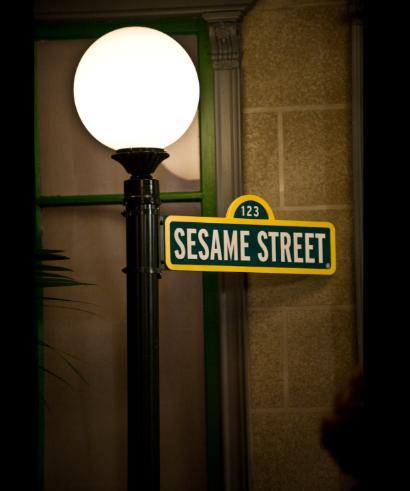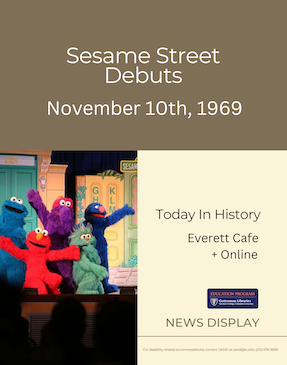Today in History: Sesame Street Debuts on National Educational Television

Created by Joan Ganz Cooney, Lloyd Morrisett, and Jim Henson, Sesame Street -- also known as Children's Television Workshop -- debuted on national educational television, via provider PBS, on November 10th, 1969. Known for its use of muppets, a colorful, lovable cast of puppet characters in short, amusing, and often humorous, musical sketches, Sesame Street opened with positive, though some controversial reviews. It became one the longest running television shows in the world. Designed to prepare young children for school by teaching the alphabet, numbers, shapes, and basic reasoning through live shorts and animation, it held their interest and attention, while introducing real life experiences occurring in a fictional street in an unspecified neighborhood in New York City.
Sesame Street continues to bridge education and culture through the learning adventures of Bert, Ernie, Oscar the Grouch, Grover, Big Bird, Elmo, Cookie Monster, other muppets and all the children and adults with whom they interact. Fun Fact: there are over 60 doctoral dissertations that explore Sesame Street as a topic, including its wide ranging influence; affect on the children's television industry; and application to specific areas of education.
The following articles are drawn from Proquest Historical Newspapers, which informs and inspires classroom teaching and learning:
- This Day on Nov. 10, 1969 Sesame Street Debuts. (2010, Nov 10). Michigan Chronicle (1939-2010)
- 'Sesame Street' Debuts Monday. (1969, Nov 10). Chicago Daily Defender (Daily Edition) (1960-1973)
- Seligsohn, L. (1970, Feb 09). Sesame Street: If You Want Proof oF TV's Impact on American Life, Take a Look at the Program That Millions of Children Are Watching, and Look What They're Learning. Newsday (1940-)
- 'Sesame Street' Is Top Show on Public Television. (1977, Nov 05). New Pittsburgh Courier (1966-1981)
- Rosenthal, H. M. (1988, Jul 17). Sunny Days on Sesame Street: The First Muppet Moppets Are College Graduates by Now. and, Nearly Two Decades After that Band of TV Furballs Began Jump-Starting Education, the Show Is Sharper Than Ever. Newsday (1940-)
- Cohen, M. (1989, Oct 29). Street Smarts: By Combining Education and Entertainment, Sesame Street Has Entranced a Generation. Boston Globe (1960-)
- Wood, D.B. Wood (1989, Nov 10). At 20, 'Sesame Street' Sets Pace for Children's TV. The Christian Science Monitor (1908-)
- China, S. (1989, Nov 15). 'Sesame Street' at 20: Taking Stock. New York Times (1923-)
- Lovece, F. (1991, Nov 10). For 'Sesame Street,' the Direct Approach. Newsday (1940-)
- Seecharan, A. (2002, Jan 23). Inclusion Is Message of 'Sesame Street Live'. Michigan Chronicle (1939-2010)
Tips:
- Cole, Charlotte F., and June H. Lee. The Sesame Effect : The Global Impact of the Longest Street in the World. New York, N.Y: Routledge, 2016. e-book
- Fisch, Shalom M., and Rosemarie T. Truglio. “G” Is for Growing : Thirty Years of Research on Children and Sesame Street. Mahwah, N.J. ; Erlbaum, 2001. Stacks ; LC6579.S47 G58 2001
- Fisch, Shalom M. Children’s Learning from Educational Television Sesame Street and Beyond. Mahwah, N.J: L. Erlbaum Associates, 2004. Stacks: LC6576 .F57 2004; e-book
- Frye, Karen Hill. Television’s Sesame Street, an Experiment in Early Education. Los Angeles: Center for Afro-American Studies, University of California, 1972. Stacks ; LB1044.7 .F79
- Lesser, Gerald S. Children and Television : Lessons from Sesame Street. [First edition]. New York: Random House, 1974. Stacks ; PN1992.77.S43 L4
- Check out the Records of the Children's Television Workshop, held in the Archives at the University of Maryland

Images:
- Sesame Street Signpost, by Josh Hallett, Courtesy of Wikimedia Commons
- Sesame Street, USO Tour Military Bases Teaching Children Life Lessons, by SGT Neysa Huertas Quininesm Courtesy of Defense Visual Information Distribution Service
Need to keep current, look to the past, teach a topic? The Everett Cafe features daily postings of news from around the world, and also promotes awareness of historical events from an educational context. Be sure to check additional Cafe News postings on the library blog.

